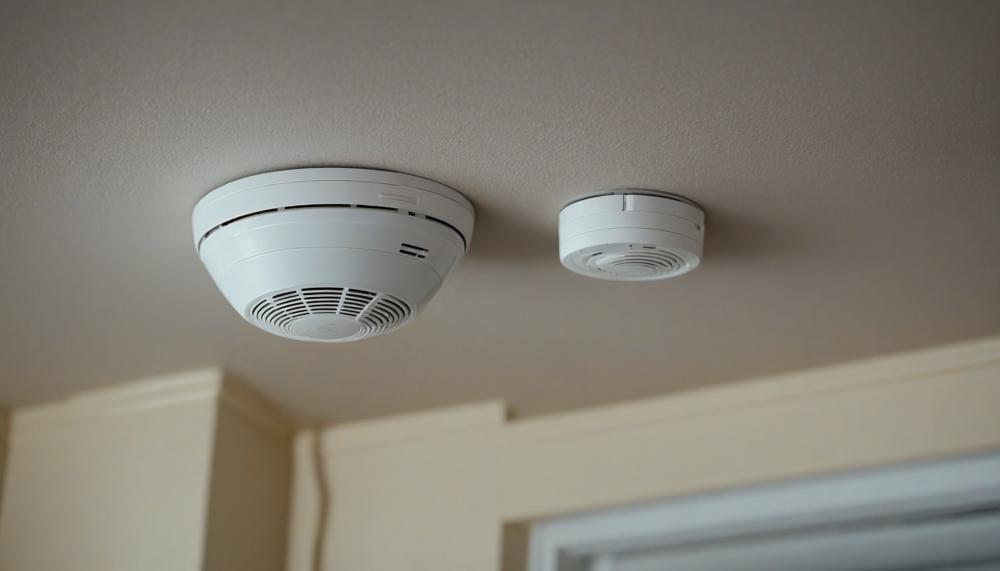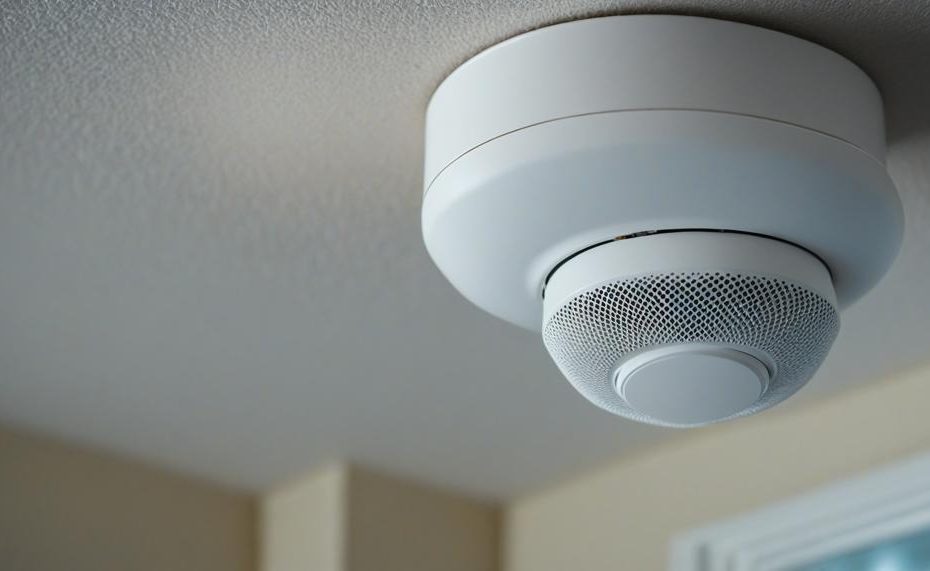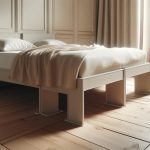Ensuring the safety of your home starts with proper smoke detector placement, especially in the bedroom where we spend a significant portion of our time sleeping and vulnerable. But where exactly should this life-saving device be installed for maximum effectiveness? The answer is straightforward: the center of the ceiling.
This spot offers the best coverage, allowing the detector to sense smoke from any part of the room efficiently. However, there are a few key guidelines to follow to optimize its performance:
- Center of the Ceiling: This is the ideal location for a smoke detector to provide equal coverage throughout the room.
- Away from Corners: If ceiling placement isn’t possible, ensure it’s at least 4 inches away from corners on the ceiling or wall.
- Distance from Doorways: Install the detector at least 10 feet away from doorways to avoid drafts that might disrupt its operation.
By adhering to these simple yet crucial guidelines, you can ensure that your bedroom smoke detector is positioned to offer the highest level of protection, giving you peace of mind as you rest. Remember, the right placement can make all the difference in the event of a fire, providing early warning and the precious seconds needed to stay safe.
Contents
Key Points
When determining the placement of a smoke detector in a bedroom, consider the following factors for optimal safety and effectiveness:
| Factor | Details | Explanation |
| Height and Location | Place smoke detectors as high as possible on the ceiling, avoiding extreme corners or pitched ceilings. | This ensures that smoke, which rises, can be detected quickly and efficiently. |
| Code Requirements | At least one smoke detector should be installed inside each bedroom. | This is essential for alerting individuals during sleep, providing an early warning before potential danger. |
| Proximity to Bathrooms | Place a smoke alarm in the hallway outside bedrooms but far enough from bathrooms. | Prevents false alarms due to steam while ensuring detection of potential dangers originating from bathrooms. |
| Central Location | Install smoke alarms on the ceiling in a central location, avoiding doors, windows, or vents. | Ensures smoke rising throughout the room is detected without interference from drafts. |
| Interconnected Alarms | Link all smoke alarms together. | When one alarm is triggered, all connected alarms will sound, providing comprehensive coverage. |
| Ceiling vs. Wall Installation | Preferably install on the ceiling; if on the wall, it should be 4-12 inches from the ceiling. | Ceiling installation provides better coverage and faster detection of smoke. |
| Maximum Effectiveness | Place the smoke detector towards the center of the ceiling. | This central position ensures equal coverage and swift detection of smoke throughout the room. |
Additional Considerations:
- Distance from Doorways: Install smoke detectors at least 10 feet away from doorways to avoid drafts disrupting their operation.
- Avoiding Drafts: Ensure detectors are not placed near air vents or windows to prevent air currents from affecting their performance.
Types of Alarms
There are various types of alarms available for smoke detectors, including ionization, photoelectric, dual-sensor, hardwired, and battery-operated. Each type has its own unique features and benefits and should be placed strategically in a bedroom for maximum effectiveness.
| Types of Alarms | Functionality | Placement in a Bedroom |
|---|---|---|
| Ionization Smoke Detectors | Uses a small amount of radioactive material to detect smoke particles in the air. Best for detecting fast-flaming fires. | Should be placed on the ceiling or high on the wall as smoke rises. |
| Photoelectric Smoke Detectors | Uses a beam of light to detect smoke particles in the air. More sensitive to slow-burning fires and better at detecting smoldering fires. | Ideal for bedrooms and should be placed on the ceiling or high on the wall away from potential sources of interference. |
| Dual-Sensor Smoke Detectors | Combines both ionization and photoelectric technology for comprehensive fire detection. | Ideal for bedrooms and should be placed on the ceiling or high on the wall away from potential sources of interference. |
| Hardwired Smoke Detectors | Connected to a home’s electrical system with battery backup. More reliable than battery-operated detectors and have interconnectivity. | Should be installed by a professional and placed on the ceiling or high on the wall in bedrooms. |
| Battery-Operated Smoke Detectors | Easy to install, but less reliable as they rely solely on batteries for power. Should be placed on the ceiling or high on the wall. | Should be regularly tested and batteries replaced for maximum effectiveness. |
When it comes to smoke detectors in a bedroom, it is essential to consider the type of alarm and its recommended placement for maximum effectiveness. It is also crucial to regularly test and replace batteries in battery-operated detectors to ensure they are functioning properly.
Where to Place Smoke Detectors and CO Alarms
This placement ensures that any potential fire or carbon monoxide threat is detected quickly and can alert occupants in both areas of the room.
According to the National Fire Protection Association (NFPA), smoke rises and spreads horizontally before it reaches the ceiling. Therefore, placing the smoke detector on the ceiling allows for early detection and warning before the smoke reaches the sleeping area. Additionally, placing the detector between the sleeping and living areas provides equal coverage for both areas.
As for CO alarms, they should be placed on the ceiling as well since carbon monoxide is also lighter than air and rises. However, it is important to note that CO alarms can also be placed on a wall at least 5 feet above the floor, as long as it is not near any fuel-burning appliances or in areas with high airflow.
It is also recommended to install interconnected smoke detectors and CO alarms throughout your home, so that if one alarm goes off, they all will. This ensures maximum safety and early detection of any potential threats.
Additionally, regular testing and maintenance of both smoke detectors and CO alarms are crucial for their effectiveness. It is recommended to test them monthly and replace the batteries twice a year. It is also important to replace smoke detectors every 10 years and CO alarms every 5-7 years.

By following these guidelines, you can ensure that your bedroom is properly equipped with effective smoke detectors and CO alarms for maximum safety against fire and carbon monoxide threats.
Alarm Placement Locations to Avoid
When it comes to placing smoke detectors in a bedroom, there are a few important factors to consider. The first is to avoid placing them directly in kitchens and bathrooms due to the potential for false alarms from cooking fumes and steam.
Additionally, it is recommended to avoid placing them in dead zones above furniture or doors, as well as drafty hallways and unheated/uncooled spaces. These areas may interfere with the smoke detector’s ability to detect smoke accurately.
Furthermore, it is advisable to avoid placing smoke detectors in dusty or dirty areas, as this can also affect their performance. It is essential to regularly clean and maintain smoke detectors to ensure they are functioning correctly.
Another crucial consideration is avoiding placing smoke detectors in corners or close to walls on the ceiling. Smoke tends to pool in the center of a ceiling before dispersing, so corner placement can delay detection. The recommended distance between a smoke detector and wall or corner is at least 4 inches when mounted on a ceiling.
Smoke Alarm Installation Tips
When it comes to installing a smoke detector in a bedroom, the placement is crucial for its effectiveness. Here are some key factors to consider when determining the optimal placement for a smoke detector in a bedroom:
- Ceiling Placement: The National Fire Protection Association recommends placing smoke detectors at the center of the ceiling. This allows for equal coverage of the entire room and sleeping area.
- Wall Placement: If a smoke detector is placed on the wall, it should be at least 4 inches away from the corner where the ceiling meets the wall. This ensures that the detector is not affected by any drafts that may enter through the corner.
- Seven Tips for Optimal Placement: To ensure maximum coverage, follow these seven tips for optimal placement:
- Avoid placing detectors near air vents, windows, or doors as drafts can disrupt their operation.
- Install detectors at least 10 feet away from doorways to avoid any disruptions that may occur when opening or closing doors.
- If your bedroom is larger or has multiple levels, consider installing multiple detectors to ensure all areas are covered.
- Avoid placing detectors near ceiling fans or other sources of air movement.
- If your bedroom has a sloped ceiling, install the detector on the high side of the slope.
- In complicated bedrooms with alcoves or separate sleeping areas, consider installing additional detectors to cover all spaces.
- For bedrooms with cathedral ceilings, install the detector within 3 feet of the peak.
- Multiple Detectors: Having multiple detectors in a bedroom can help pinpoint the location of a fire and aid firefighters in rescue efforts. It also ensures that all areas of the bedroom are covered in case one detector fails.
- Placement Away from Doorways: Placing detectors at least 10 feet away from doorways allows them to operate without any disruptions and ensures that they can detect any smoke entering through open doors.
- Commanding Position: Placing smoke detectors at the center of the ceiling allows them to cover all areas equally and be in a commanding position. This ensures maximum effectiveness in detecting any smoke or fire.
So, when determining the optimal placement for a smoke detector in a bedroom, it is important to consider ceiling placement, wall placement, following the seven tips for optimal placement, having multiple detectors, placement away from doorways, and ensuring a commanding position.
Power Sources
The different types of power sources for smoke detectors include battery-operated, hardwired, and combination.
While both battery-operated and hardwired smoke detectors are suitable for placement in a bedroom, it is recommended to have a backup battery in case of a power outage for hardwired smoke detectors.
Conclusion
In conclusion, proper placement of smoke detectors in a bedroom is crucial for ensuring the safety and protection of your home.
The center of the ceiling is the ideal location for maximum coverage and effectiveness. However, it is important to follow additional guidelines such as avoiding corners and doorways, installing interconnected alarms, and considering the type of alarm for optimal performance.
By following these recommendations, you can rest easy knowing that your bedroom is equipped with life-saving devices in case of a fire emergency.





